Suitability Pre-Assessment of in-Sewer Heat Recovery Sites Combining Energy and Wastewater Perspectives
Abstract
:1. Introduction
2. Materials and Methods
2.1. Theory Framework
2.2. Pre-Assessment Procedure Development
2.3. Case Study Site
- measurement point (MP) 1: dry weather flow of around 30–40 L/s and about 19 °C
- measurement point (MP) 2: dry weather flow of around 20–30 L/s and about 18 °C
- measurement point (MP) 3: dry weather flow of about 5 L/s and about 19 °C
3. Results
3.1. Energy- and Wastewater-Related Categories
- Supply distance: The supply distance between the sites of heat recovery and heat demand/consumption and the related transportation heat loss, respectively, limit the economic feasibility of an in-sewer heat supply system [23,24]. Otherwise, if the point of heat consumption is in close vicinity to the local WWTP, heat recovery from the effluent might even be more favorable compared to in-sewer heat recovery [23].
- Wastewater flow rate: The dry weather wastewater flow (depending on the PEs connected upstream) at the intended in-sewer heat recovery site determines the available heat recovery potential [22,23,24]. In this context it should be mentioned that wastewater temperature during dry weather also plays an important role. However, this parameter cannot be derived from easily accessible sources (such as connected PEs) but must be measured, and thus requires more effort for data collection. For this reason, we did not consider wastewater temperature in our pre-assessment procedure. However, as stated in the discussion section of this article, in-sewer measurements are recommended as a subsequent investigation step for locations that appear promising after the pre-assessment. In this context it is also necessary to mention that due to the possible seasonal variation of wastewater flow and temperature measurement, campaigns are recommended to be carried out during the heating period.
- Wastewater temperature-related requirements/constraints: The main purpose of a WWTP is water pollution control. The performance of wastewater treatment and especially nitrogen removal efficiency strongly depends on wastewater temperature. Related threshold values are defined according to national laws/guidelines prohibiting in-sewer heat recovery from interfering with the protection of the receiving waters [23,24].
- Share of total wastewater flow: The wastewater flow at the intended in-sewer heat recovery site compared to the total flow at the influent of the WWTP is related to the expectable heat-extraction impact (cooling) on the influent of the WWTP. The lower the share of the flow at the intended in-sewer heat recovery site, the less significant the possible impact of heat extraction on the wastewater temperature at the inflow of a WWTP. This is important in regard to the temperature-sensitive processes in a WWTP [22,23,24].
3.2. Selection of Assessment Criteria
3.2.1. Heat Demand
3.2.2. Supply Distance
3.2.3. Wastewater Flow Rate
- PRS = Wastewater heat extraction [kW]
- PHP = Supplied heat demand [kW]
- COP = Coefficient of performance = 5
- ΔTRS = Wastewater heat extraction [K]
- QRS = Wastewater flow rate (dry weather) [L/s]
- c = Specific heat capacity of 4.2 kJ/kg*K (or 1.16 kWh/m3*K)
3.2.4. Operating Hours
3.2.5. Wastewater Temperature-Related Requirements/Constraints
3.2.6. Share of Total Wastewater Flow
3.2.7. Remaining Flow Distance
3.2.8. Sewer Operation and Maintenance
3.3. Method for Suitability Pre-Assessment
3.4. Case Study Application
4. Discussion
4.1. Interpretation of Case Study Results
4.2. Practicability of the Proposed Method
4.3. Strengths and Weaknesses of the Approach
5. Conclusions
Author Contributions
Funding
Acknowledgments
Conflicts of Interest
Appendix A
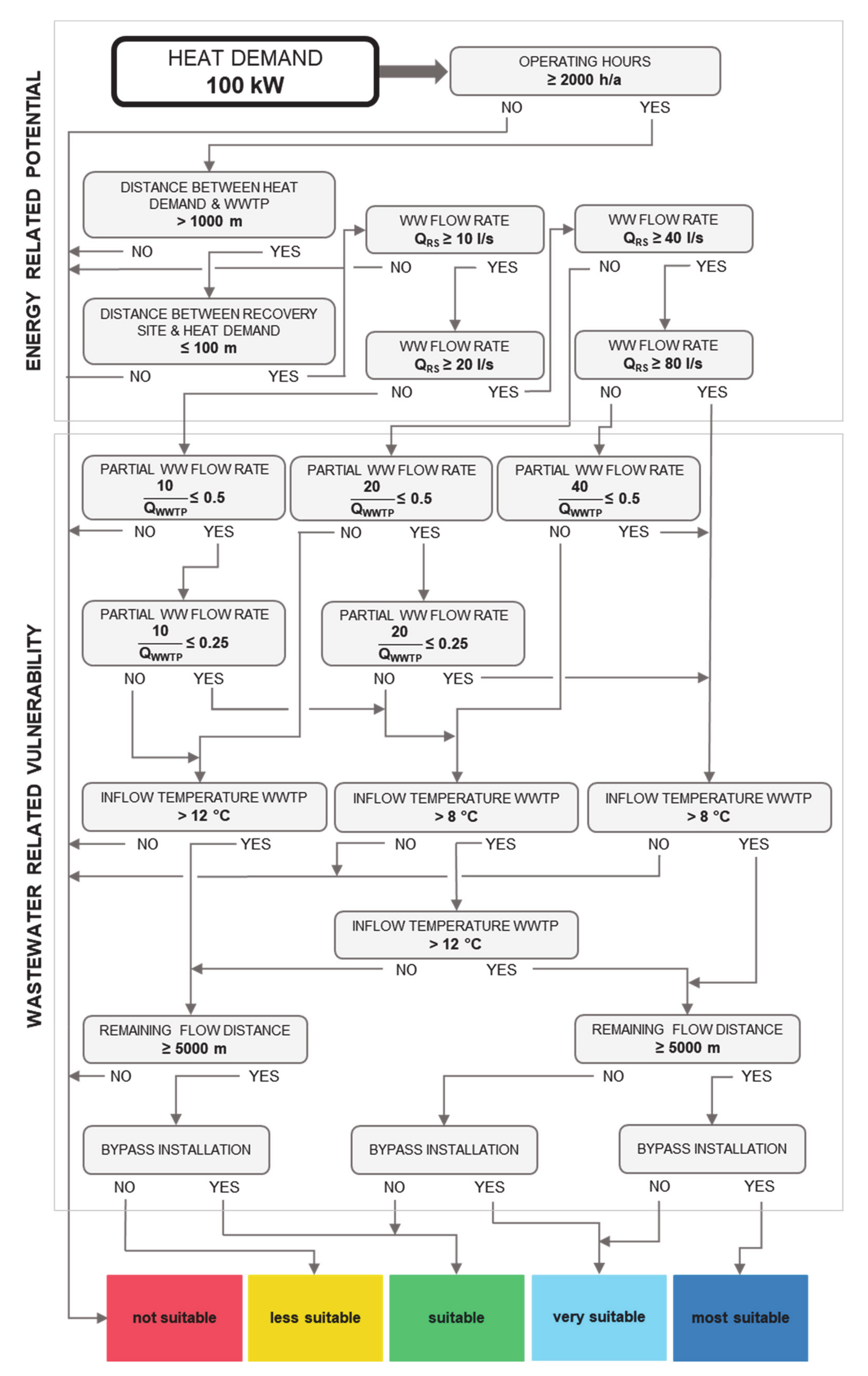
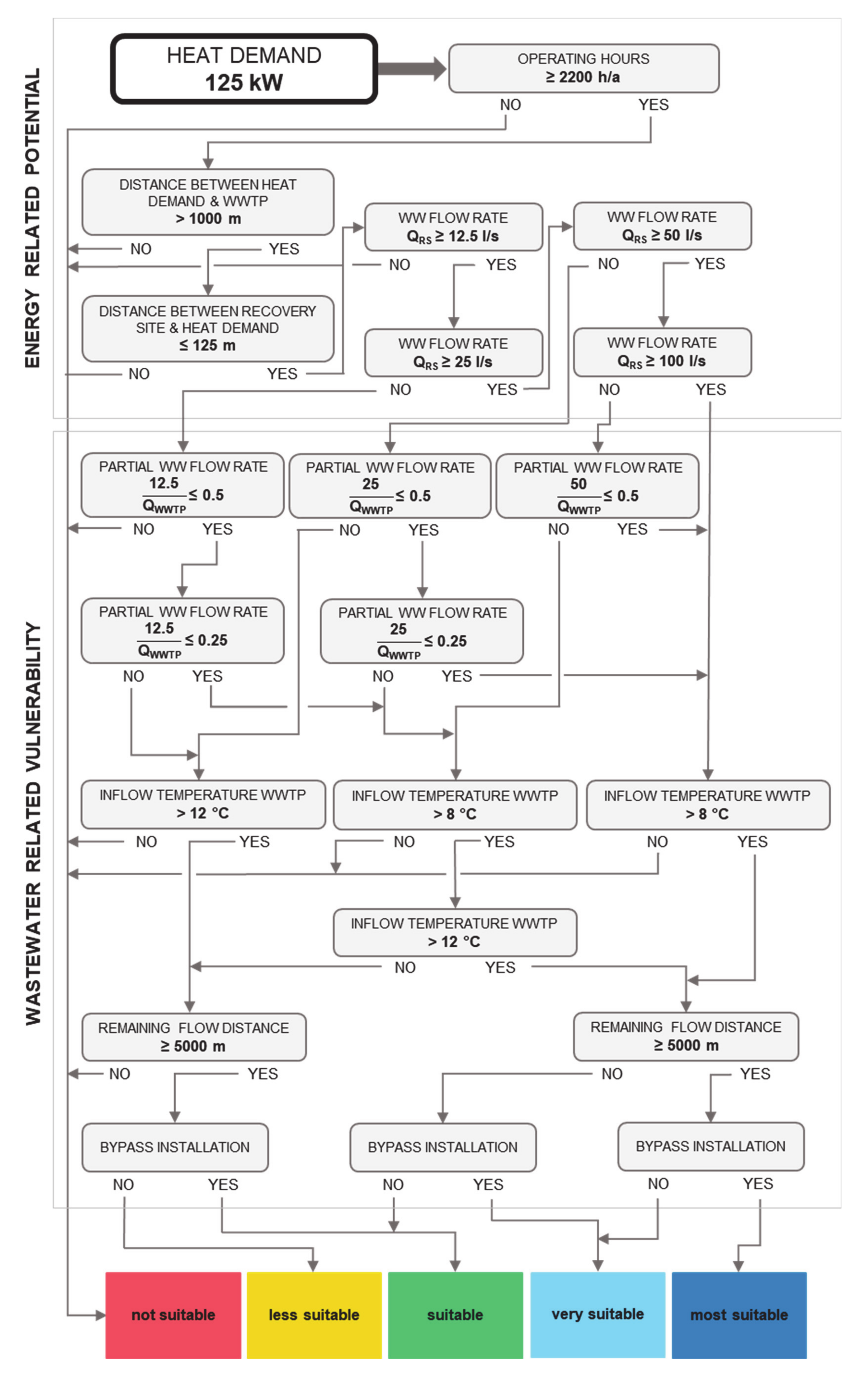

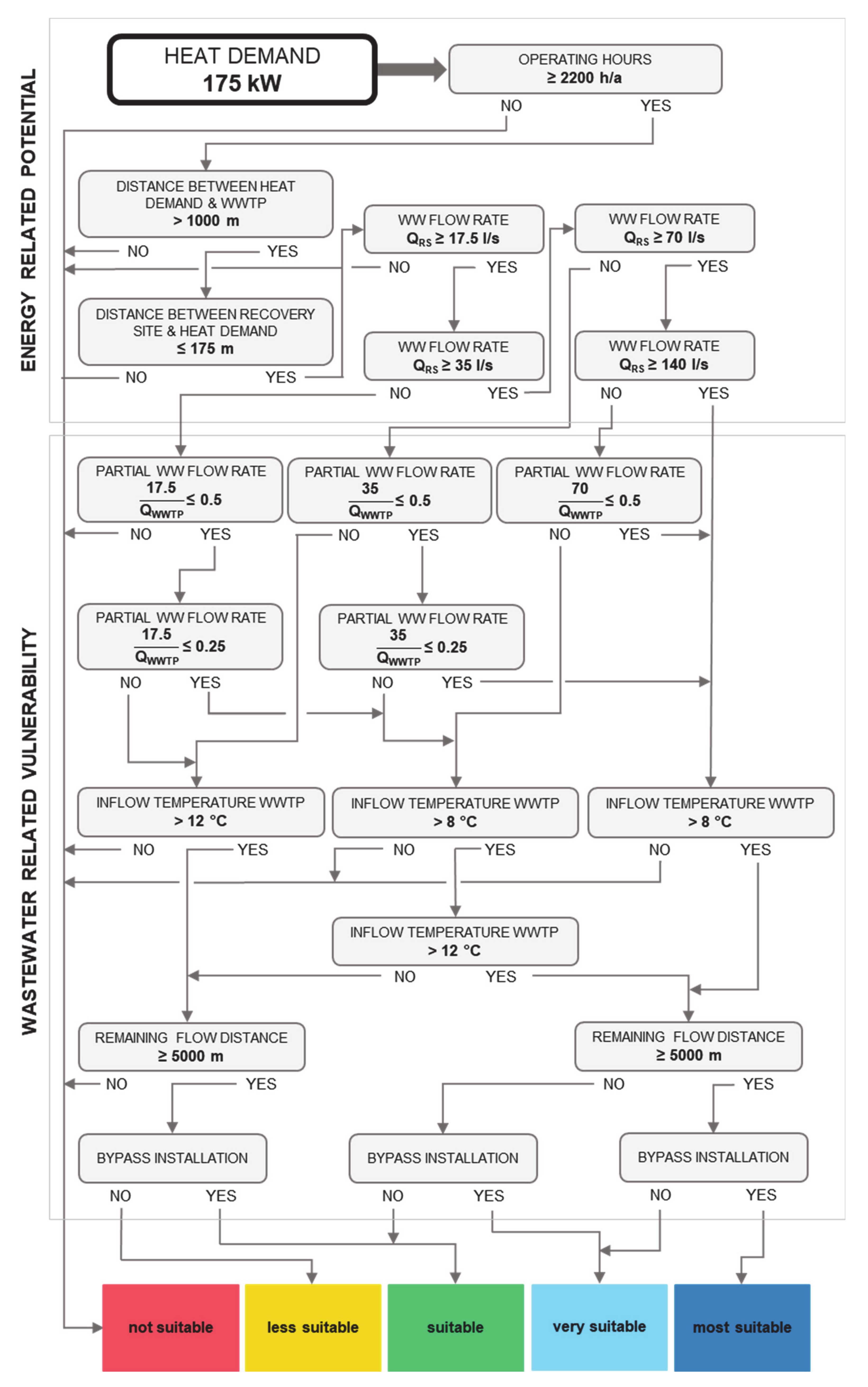

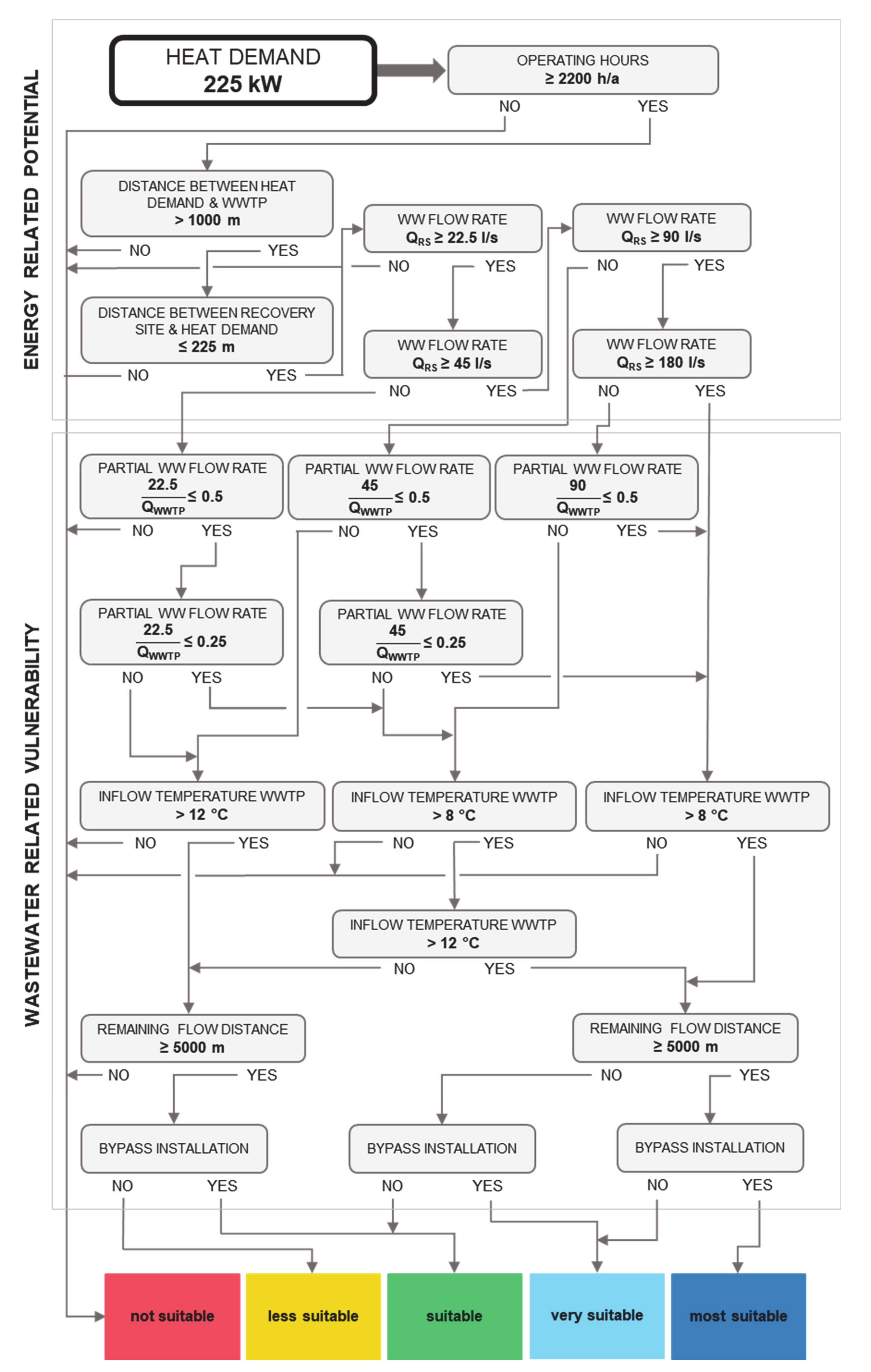
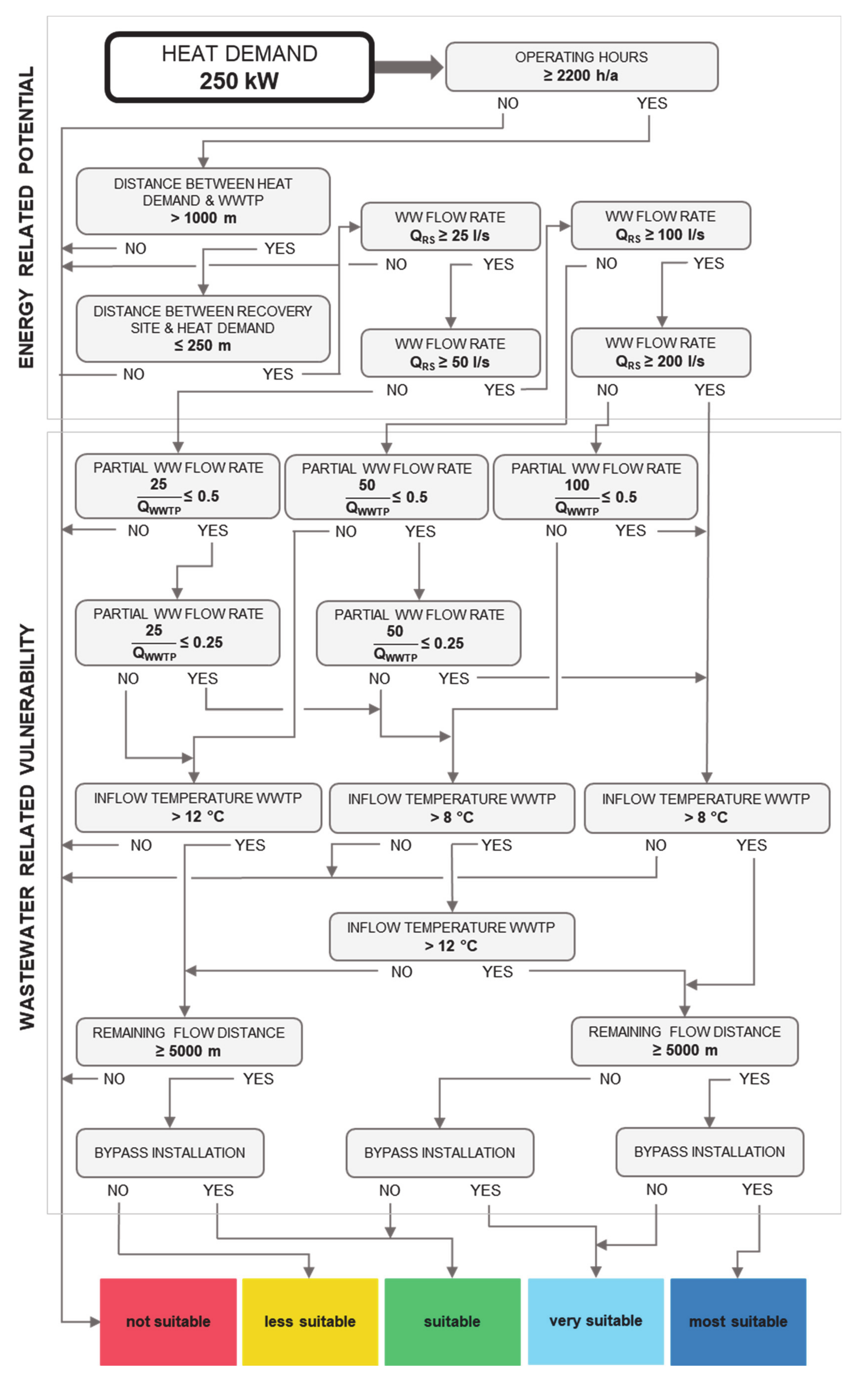
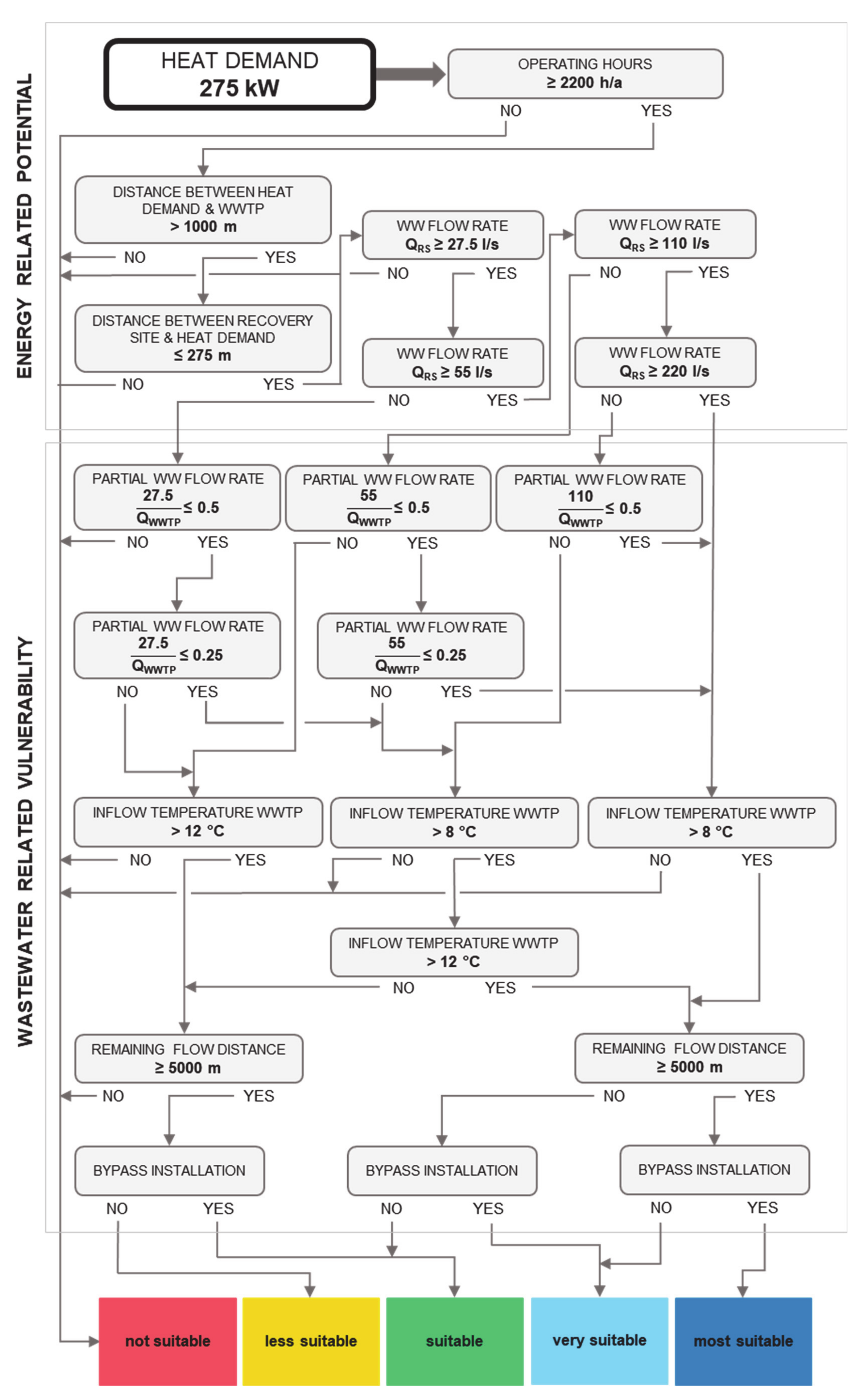
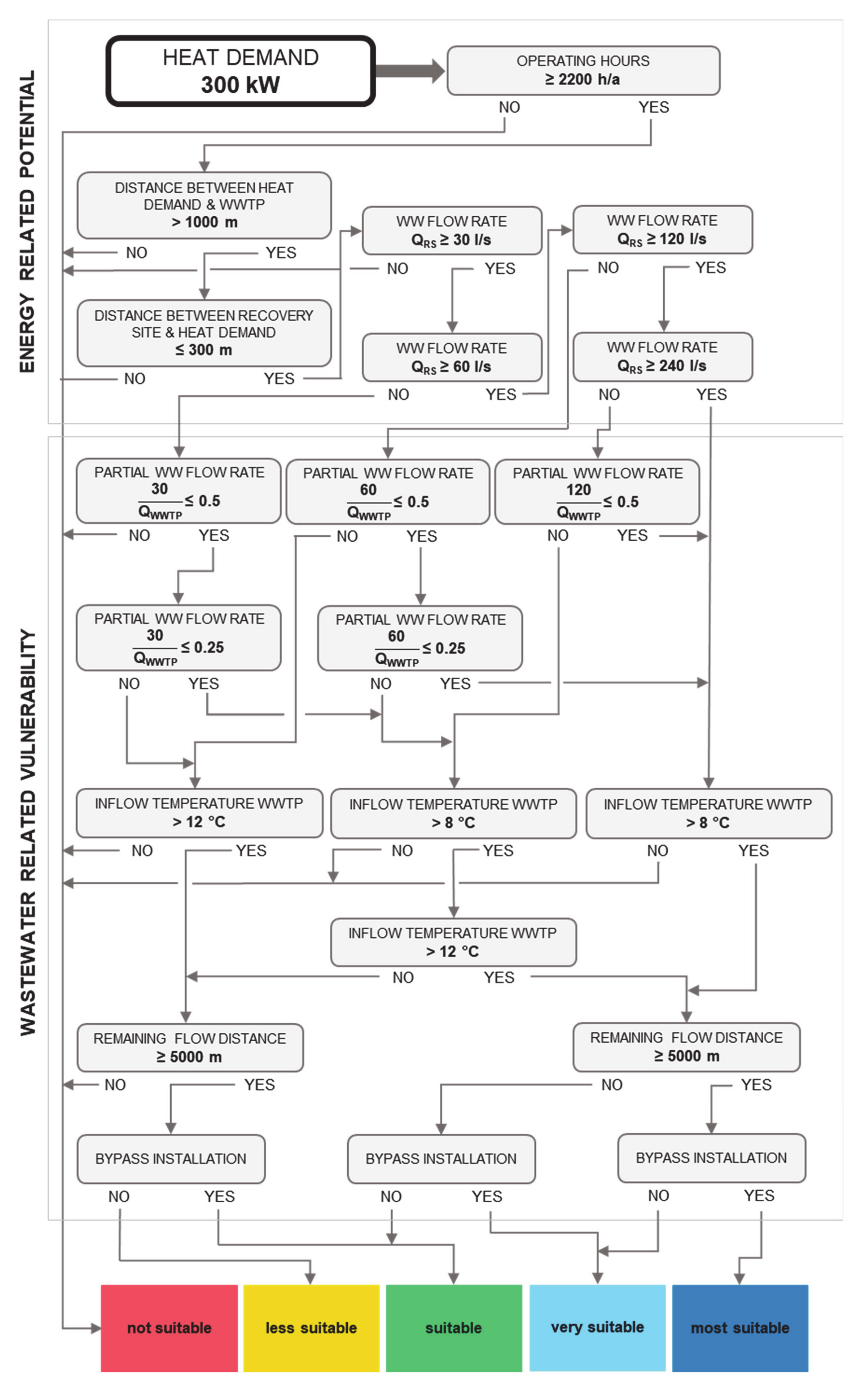
References
- United Nations. Transforming our World: The 2030 Agenda for Sustainable Development; United Nations: New York, NY, USA, 2015; Resolution adopted by the General Assembly on 25 September 2015; A/RES/70/1. [Google Scholar]
- European Commission. 2030 Climate & Energy Framework. Available online: https://ec.europa.eu/clima/policies/strategies/2030_en (accessed on 14 October 2020).
- European Commission. Communication from the Commission to the European Parliament, the Council, the European Economic and Social Committee and the Committee of the Regions—An EU Strategy on Heating and Cooling; European Commission: Brussels, Belgium, 2016. [Google Scholar]
- European Parliament and the Council. Directive (EU) 2018/2001; Promotion of the use of Energy from Renewable Sources (recast); European Parliament and the Council: Brussels, Belgium, 2018. [Google Scholar]
- Schmid, F. (s.a.): Sewage Water: Interesting Heat Source for Heat Pumps and Chillers. In Proceedings of the 9th International IEA Heat Pump Conference, Zürich, Switzerland, 20–22 May 2008. [Google Scholar]
- Elías-Maxil, J.A.; van Der Hoek, J.P.; Hofman, J.; Rietveld, L. Energy in the urban water cycle: Actions to reduce the total expenditure of fossil fuels with emphasis on heat reclamation from urban water. Renew. Sustain. Energy Rev. 2014, 30, 808–820. [Google Scholar] [CrossRef] [Green Version]
- Neugebauer, G.; Kretschmer, F.; Kollmann, R.; Narodoslawsky, M.; Ertl, T.; Stoeglehner, G. Mapping thermal energy resource potentials from wastewater treatment plants. Sustainability 2015, 7, 12988–13010. [Google Scholar] [CrossRef] [Green Version]
- Hao, X.; Li, J.; van Loosdrecht, M.C.M.; Han, J.; Liu, R. Energy recovery from wastewater: Heat over organics. Water Res. 2019, 161, 74–77. [Google Scholar] [CrossRef] [PubMed]
- Frijns, J.; Hofman, J.; Nederlof, M. The potential of (waste)water as energy carrier. Energy Convers. Manag. 2013, 64, 357–363. [Google Scholar] [CrossRef]
- Culha, O.; Gunerhan, H.; Biyik, E.; Ekren, O.; Hepbasli, A. Heat exchanger applications in wastewater source heat pumps for buildings: A key review. Energy Build. 2015, 104, 215–232. [Google Scholar] [CrossRef]
- Wanner, O.; Panagiotidis, V.; Clavadetscher, P.; Siegrist, H. Effect of heat recovery from raw wastewater on nitrification and nitrogen removal in activated sludge plants. Water Res. 2005, 39, 4725–4734. [Google Scholar] [CrossRef] [PubMed]
- European Standard EN 752:2017. Drain and Sewer Systems Outside Buildings—Sewer System Management; European Committee for Standardization: Brussels, Belgium, 2017.
- Kretschmer, F.; Simperler, L.; Ertl, T. Analysing wastewater temperature development in a sewer system as a basis for the evaluation of wastewater heat recovery potentials. Energy Build. 2016, 128, 639–648. [Google Scholar] [CrossRef]
- Dürrenmatt, D.; Wanner, O. A mathematical model to predict the effect of heat recovery on the wastewater temperature in sewers. Water Res. 2014, 48, 548–558. [Google Scholar] [CrossRef] [PubMed]
- Elías-Maxil, J.A.; Hofman, J.; Wols, B.; Clemens, F.; van der Hoek, J.P.; Rietveld, L. Development and performance of a parsimonious model to estimate temperature in sewer networks. Urb. Water J. 2017, 14, 829–838. [Google Scholar] [CrossRef] [Green Version]
- Abdel-Aal, M.; Mohamed, M.; Smits, R.; Abdel-Aal, R.E.; de Gussem, K.; Schellart, A.; Tait, S. Predicting wastewater temperatures in sewer pipes using abductive network models. Water Sci. Technol. 2015, 71, 89–96. [Google Scholar] [CrossRef] [PubMed]
- Schlagbauer, P. Thermische Energiegewinnung aus Abwasser—Entwicklung eines Temperaturmodells für SWMM (Thermal Energy Recovery from Wastewater–Development of a Temperture Model for SWMM). Master’s Thesis, Technical University of Graz, Graz, Austria, 2018. [Google Scholar]
- Wärff, C.; Arnell, M.; Sehlén, R.; Jeppson, U. Modelling heat recovery potential from household wastewater. Water Sci. Technol. 2020, 81, 1597–1605. [Google Scholar] [CrossRef] [PubMed] [Green Version]
- Golzar, F.; Nilsson, D.; Martin, V. Forecasting wastewater temperature based on artificial neural network (ANN) technique and Monte Carlo sensitivity analysis. Sustainability 2020, 12, 6386. [Google Scholar] [CrossRef]
- Fürst, D.; Scholles, F. Handbuch Theorien und Methoden der Raum- und Umweltplanung. In Handbook on Theories and Methods in Spatial and Environmental Planning; Rohn: Dortmund, Germany, 2008. [Google Scholar]
- Stöglehner, G. Grundlagen der Raumplanung 1—Theorien, Methoden, Instrumente (Basics of Spatial Planning 1-Theories, Methods, Instruments); Stöglehner, G., Ed.; Facultas: Vienna, Austria, 2019; p. 332. [Google Scholar]
- Koch, M.; Nietlisbach, A.; Känel, B.; Calderoni, M.; Wille, B.; Müller, R.; Bretscher, P.; Wanner, O.; Siegrist, H.; Peter, A.; et al. Heizen und Kühlen mit Abwasser—Leitfaden für die Planung, Bewilligung und Realisierung von Anlagen zur Abwasserenergienutzung (Heating and Cooling with Wastewater–guideline for Planning, Approving and Realising Energetic use of Wastewater); Amt für Abfall, Wasser, Energie und Luft: Zürich, Switzerland, 2010. [Google Scholar]
- Project Team „Abwasserenergie“. Abwasserenergie–Die Kläranlage als regionale Energiezelle (Wastewater Treatment Plants as Regional Energy Cells). Available online: http://www.abwasserenergie.at/fileadmin/energie_aus_abwasser/user_upload/Broschuere_Abwasserenergie_2017.pdf (accessed on 15 October 2020).
- Merkblatt DWA-M114 Abwasserwärmenutzung (Wastewater Heat Recovery); German Water Association: Hennef, Germany, 2020.
- Wiedemann, R. Spot Check on In-sewer Wastewater Flows and Temperatures at Three Different In-sewer Sites Carried out by Rabmer GreenTech, Written communication from 14 July 2020, provided by the local wastewater utility.
- Local wastewater utility. Average Wastewater Flows and Temperatures at the Local Wastewater Treatment Plant, Oral communication on 28 September 2020.
- Zeus, R. Erschließungslängen bei der Versorgung mit Abwasserwärme aus Kanalisationsanlagen—Erfahrungen aus Projektumsetzungen der UHRIG Energie GmbH. (Supply Distances of In-sewer Wastewater Heat Recovery-practical Experiences of UHRIG Energie GmbH), Written communication from 23 April 2020.
- Huber, F. Vorbewertung eines Standortes zur Abwasserwärmenutzung im Kanal aus energie-und abwasserwirtschaftlicher Sicht (Pre-assessment of an In-sewer Heat Recovery Site from Energy and Wastewater Perspectives). Master’s Thesis, University of Natural Resources and Life Sciences, Vienna, Austria, 2020. [Google Scholar]
- AEVkA. Verordnung des Bundesministers für Land- und Forstwirtschaft über die Begrenzung von Abwasseremissionen aus Abwasserreinigungsanlagen für Siedlungsgebiete (Order of the Federal Minister of Agriculture, Forestry, Environment and Water Management concerning Limitations of Wastewater Emissions from Wastewater Treatment Plants for Settlement Areas), BGBl. Nr. 210/1996 idF. BGBl. II Nr. 392/2000, Vienna.
- Bischofsberger, W.; Seyfried, C.F. Wärmeentnahme aus Abwasser (Heat Extraction from Wastewater); Lehrstuhl und Prüfamt für Wassergütewirtschaft und Gesundheitsingenieurwesen der Technischen Universität München: Garching, Germany, 1984. [Google Scholar]
- Cipolla, S.S.; Maglionico, M. Heat recovery from urban wastewater: Analysis of the variability of flow rate and temperature. Energy Build. 2014, 69, 122–130. [Google Scholar] [CrossRef]
- Wanner, O.; Delavy, P.; Eugster, J.; Panagiotidis, V.; Siegrist, H. Wärmerückgewinnung aus Abwassersystemen. Schlussbericht (Heat Recovery from Wastewater Systems. Final Report); By order of Bundesamt für Energie: Dübendorf, Switzerland, 2004. [Google Scholar]
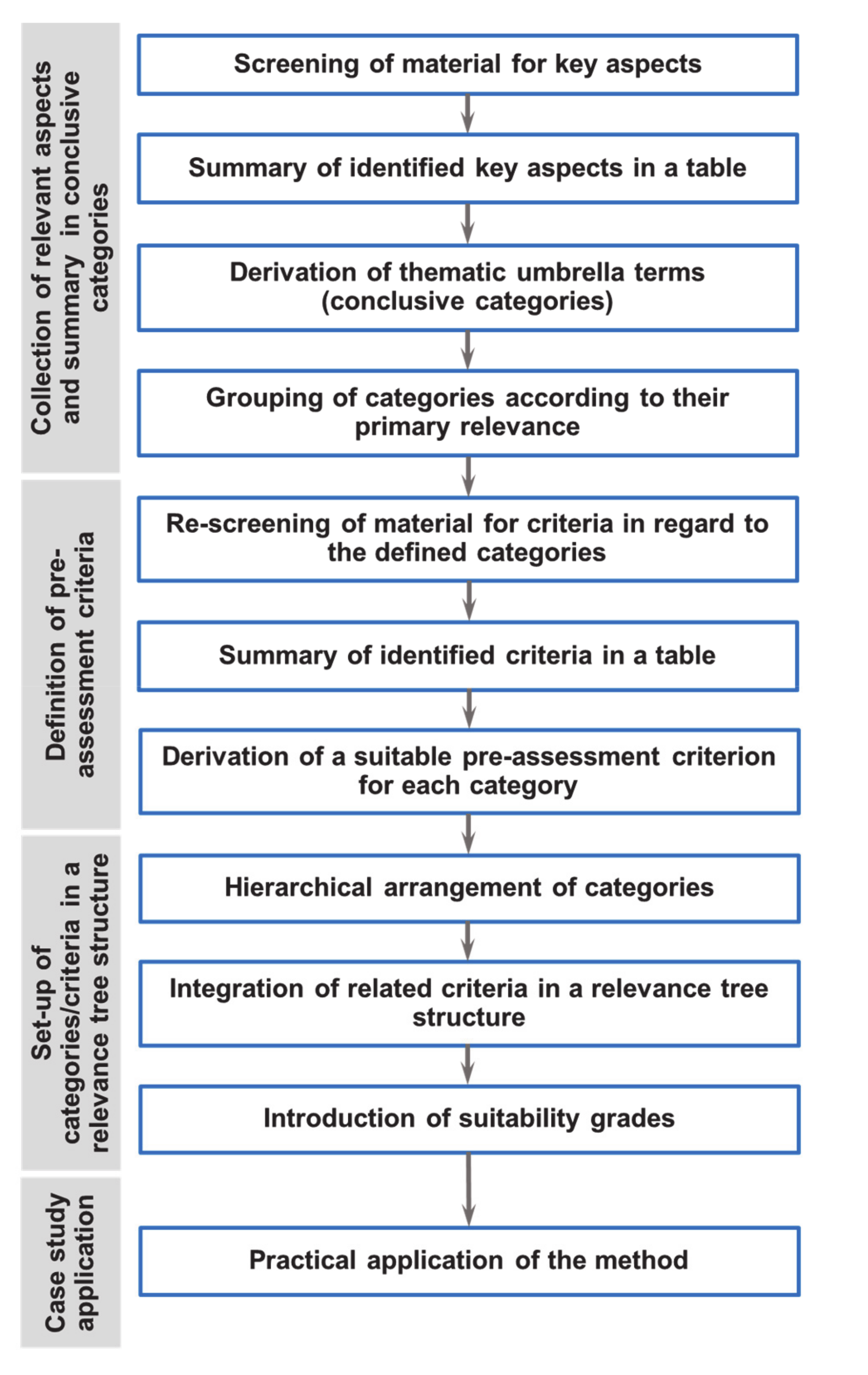
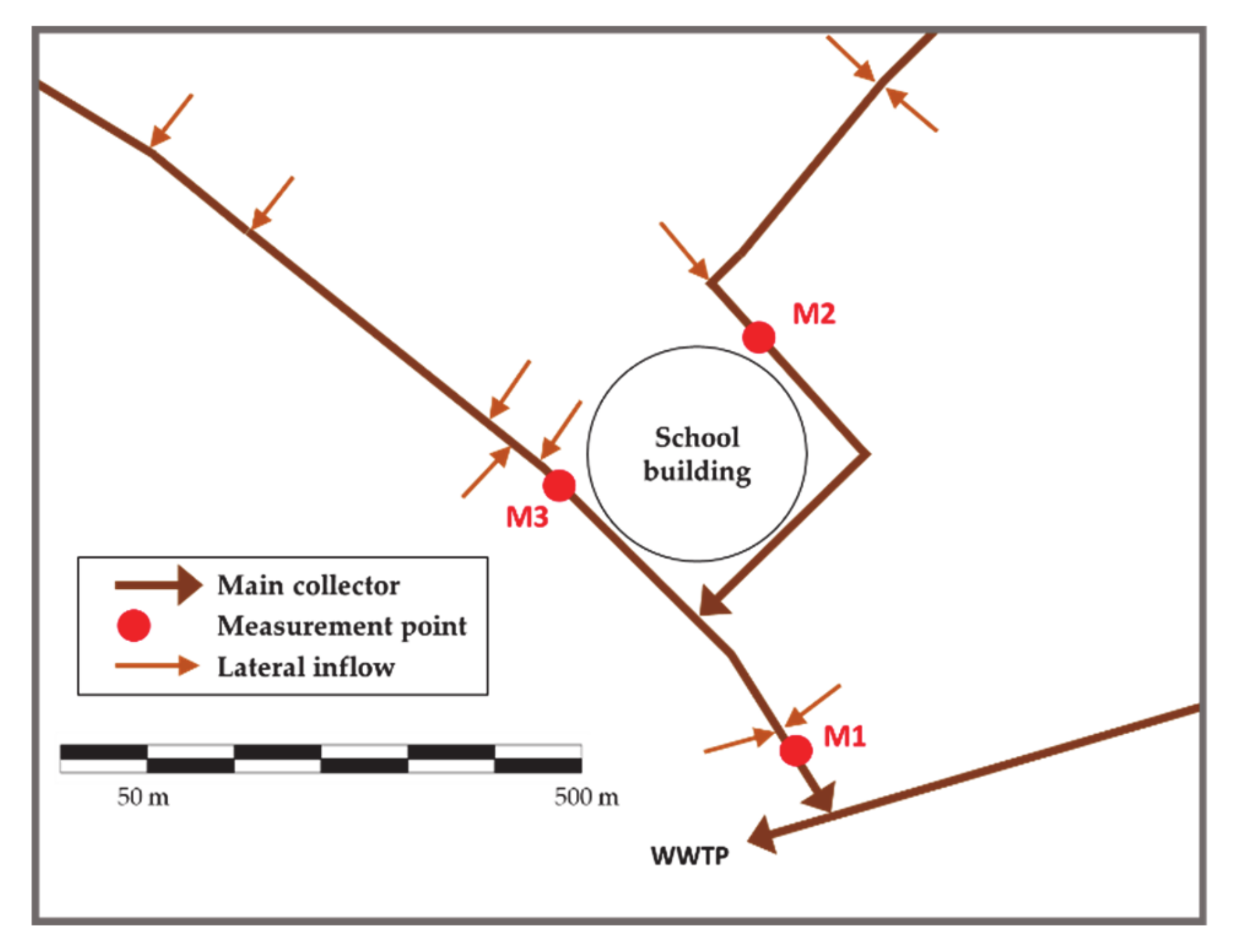

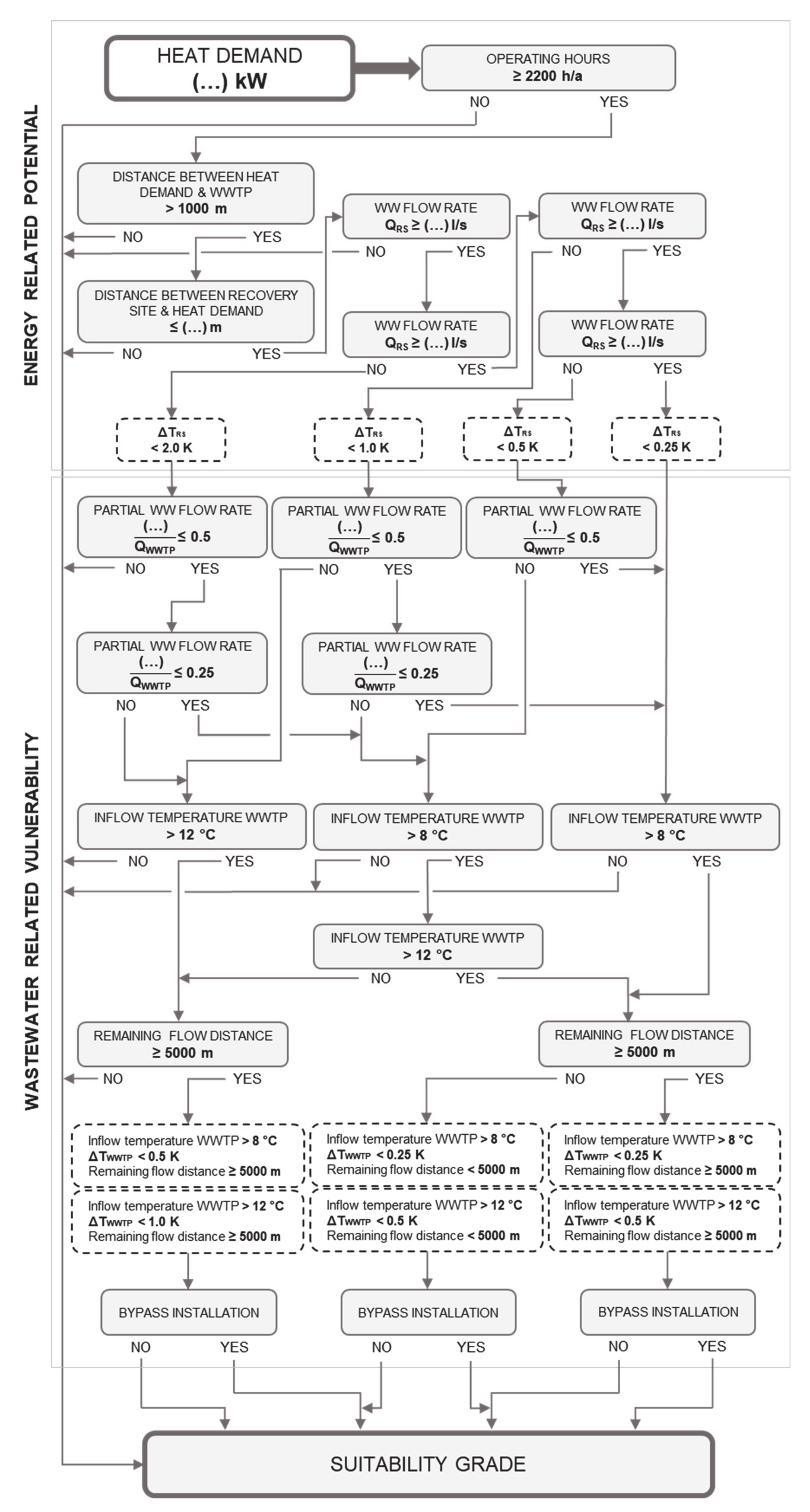
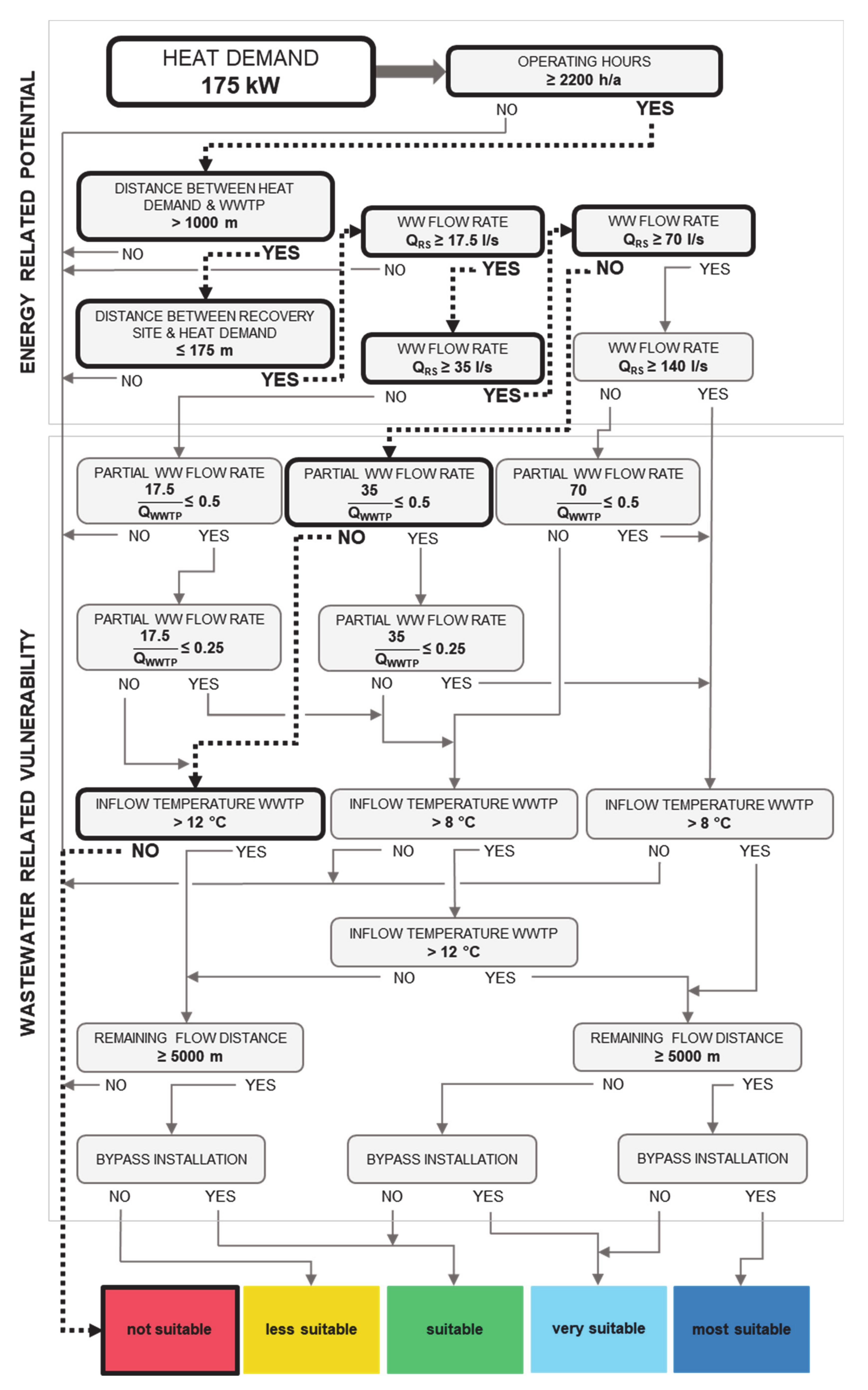


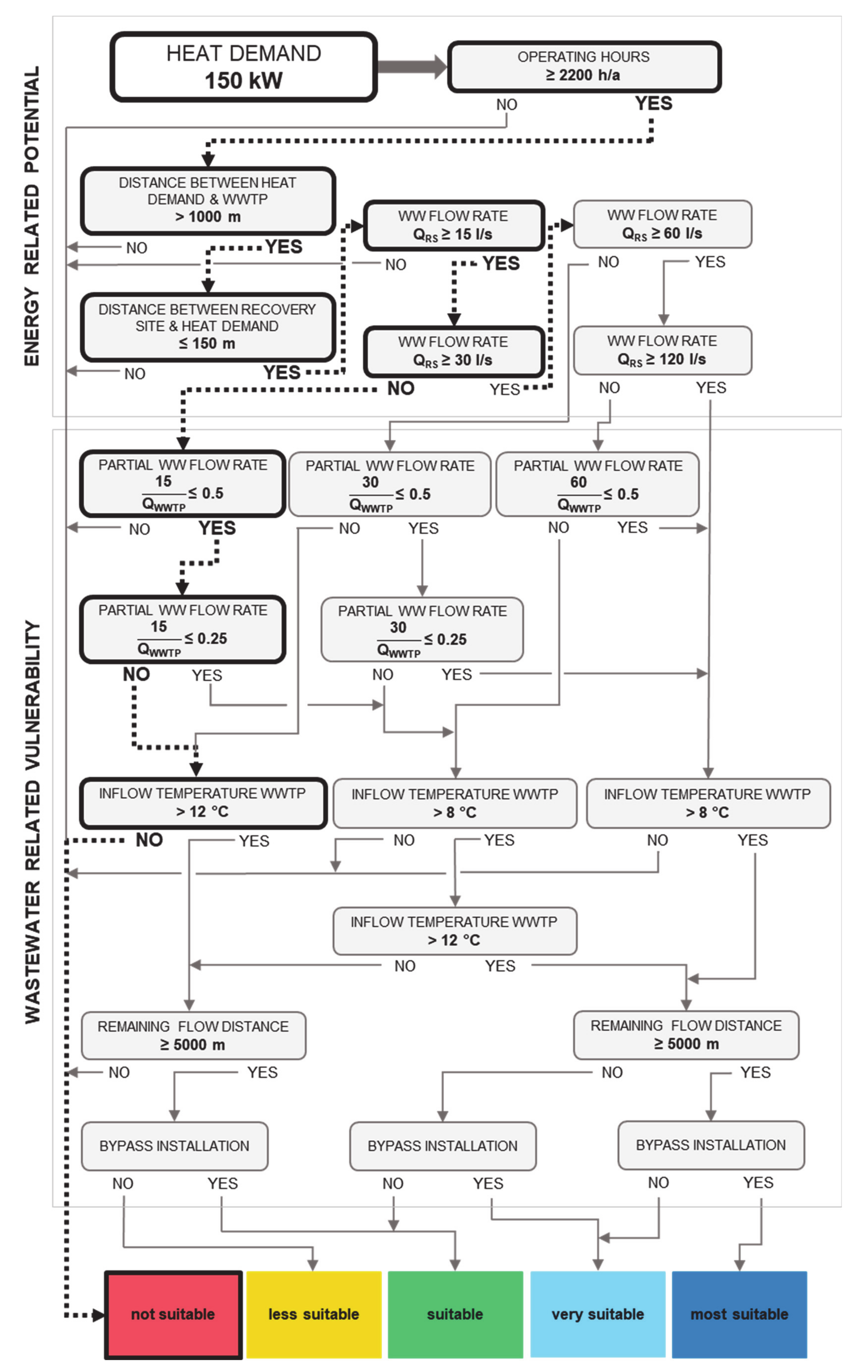

| Heat Demand (kW) | Bridgeable Supply Distance (m) |
|---|---|
| 100 | ≤100 |
| 125 | ≤125 |
| 150 | ≤150 |
| 175 | ≤175 |
| 200 | ≤200 |
| 225 | ≤225 |
| 250 | ≤250 |
| 275 | ≤275 |
| 300 | ≤300 |
| Heat Demand PHP (kW) | Dry Weather Wastewater Flow Rate QRS (L/s) | |||
|---|---|---|---|---|
| 100 | ≥10 | ≥20 | ≥40 | ≥80 |
| 125 | ≥12.5 | ≥25 | ≥50 | ≥100 |
| 150 | ≥15 | ≥30 | ≥60 | ≥120 |
| 175 | ≥17.5 | ≥35 | ≥70 | ≥140 |
| 200 | ≥20 | ≥40 | ≥80 | ≥160 |
| 225 | ≥22.5 | ≥45 | ≥90 | ≥180 |
| 250 | ≥25 | ≥50 | ≥100 | ≥200 |
| 275 | ≥27.5 | ≥55 | ≥110 | ≥220 |
| 300 | ≥30 | ≥60 | ≥120 | ≥240 |
| Heat extraction ΔTRS (K) (rounded) | <2.0 | <1.0 | <0.5 | <0.25 |
| Approximate distance to WWTP | 10 km | ||
| Inflow temperature at the WWTP | 8.2 °C | ||
| Inflow rate at the WWTP | 40 L/s | ||
| Assumed size of the heated floor space | 5000 m2 | ||
| Assumed heating demand | 100 kWh/m2*a | ||
| Assumed operating hours of the heat recovery system | 3000 h/a | ||
| Estimated total heat demand of the school building | 170 kW | ||
| Applied heat demand (selected relevance tree) | 175 kW | ||
| Heat recovery site | M1 | M2 | M3 |
| Distance between recovery and supply site | 150 m | 50 m | 50 m |
| In-sewer wastewater flow rate | 35 L/s | 25 L/s | 5 L/s |
| Remaining flow distance | 10 km | 10 km | 10 km |
| Bypass installation possible | yes | yes | yes |
Publisher’s Note: MDPI stays neutral with regard to jurisdictional claims in published maps and institutional affiliations. |
© 2020 by the authors. Licensee MDPI, Basel, Switzerland. This article is an open access article distributed under the terms and conditions of the Creative Commons Attribution (CC BY) license (http://creativecommons.org/licenses/by/4.0/).
Share and Cite
Huber, F.; Neugebauer, G.; Ertl, T.; Kretschmer, F. Suitability Pre-Assessment of in-Sewer Heat Recovery Sites Combining Energy and Wastewater Perspectives. Energies 2020, 13, 6680. https://doi.org/10.3390/en13246680
Huber F, Neugebauer G, Ertl T, Kretschmer F. Suitability Pre-Assessment of in-Sewer Heat Recovery Sites Combining Energy and Wastewater Perspectives. Energies. 2020; 13(24):6680. https://doi.org/10.3390/en13246680
Chicago/Turabian StyleHuber, Franz, Georg Neugebauer, Thomas Ertl, and Florian Kretschmer. 2020. "Suitability Pre-Assessment of in-Sewer Heat Recovery Sites Combining Energy and Wastewater Perspectives" Energies 13, no. 24: 6680. https://doi.org/10.3390/en13246680
APA StyleHuber, F., Neugebauer, G., Ertl, T., & Kretschmer, F. (2020). Suitability Pre-Assessment of in-Sewer Heat Recovery Sites Combining Energy and Wastewater Perspectives. Energies, 13(24), 6680. https://doi.org/10.3390/en13246680






